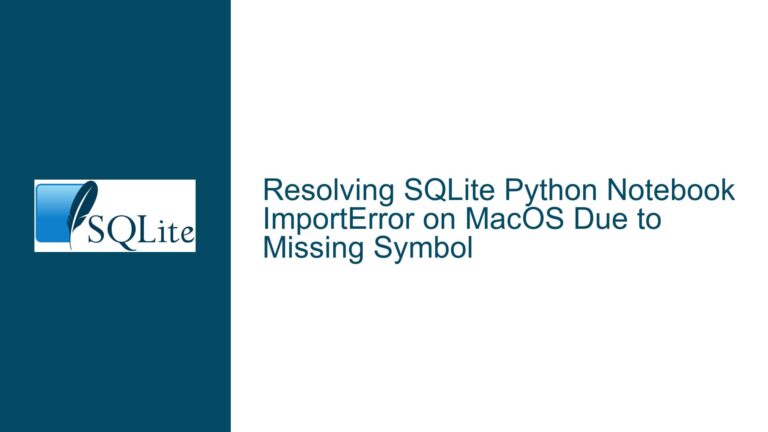Missing Closing Brace in SQLite’s vdbe.c Switch/Case Block
Issue Overview: Missing Closing Brace in Nested Case Statements
The issue at hand revolves around a seemingly missing closing brace in a switch/case block within the vdbe.c file of SQLite’s source code. Specifically, the case OP_ReopenIdx block appears to lack a closing brace before the subsequent case OP_OpenRead and case OP_OpenWrite statements. This observation initially suggests a potential syntax error or oversight in the code structure. However, upon closer inspection, it becomes evident that the closing brace is present further down in the code, albeit not immediately before the next case statement. This structure raises questions about the validity and purpose of nesting case statements within a single block, as well as the implications for variable scope and control flow within the switch statement.
The switch/case construct in C is a control flow mechanism that allows for multi-way branching based on the value of an expression. Each case label represents a specific value or range of values that the expression might take, and the corresponding block of code is executed when a match occurs. Typically, each case block is enclosed within its own set of braces {} to delineate the scope of variables declared within that block. However, in this instance, the case OP_ReopenIdx block is left open, and the subsequent case statements are nested within the same block. This structure is unconventional and can lead to confusion, especially for developers who are accustomed to the more common practice of enclosing each case block within its own set of braces.
The primary concern here is whether this structure is intentional and, if so, what purpose it serves. Additionally, there is the question of whether this structure could lead to unintended side effects, such as variable scope issues or control flow anomalies. The discussion also touches on the use of break statements within case blocks, which are typically used to exit the switch statement and prevent fall-through to subsequent case blocks. The absence of a break statement in the case OP_ReopenIdx block further complicates the matter, as it suggests that control flow may intentionally fall through to the subsequent case statements.
Possible Causes: Intentional Nesting and Variable Scope Management
The nested case structure observed in vdbe.c is not a common pattern in C programming, but it is not inherently incorrect. The C language allows for a great deal of flexibility in how switch/case statements are structured, and this flexibility can be leveraged to achieve specific control flow or variable scoping objectives. In this case, the nested case structure appears to be intentional, serving two primary purposes: variable scope management and control flow optimization.
Variable Scope Management: One of the key reasons for nesting case statements within a single block is to manage the scope of variables declared within that block. In C, variables declared within a block (enclosed by braces {}) are local to that block and are not accessible outside of it. By nesting multiple case statements within a single block, the developer can ensure that variables declared within the block are accessible to all nested case statements. This can be particularly useful when multiple case statements need to share the same set of variables, as is the case in the vdbe.c file.
In the context of vdbe.c, the case OP_ReopenIdx block declares several variables, including nField, pKeyInfo, p2, iDb, wrFlag, pX, pCur, and pDb. These variables are used within the case OP_ReopenIdx block and are also referenced in the subsequent case OP_OpenRead and case OP_OpenWrite blocks. By nesting these case statements within a single block, the developer ensures that these variables remain in scope and can be accessed by all three case statements. This approach eliminates the need to redeclare the variables in each case block, reducing code duplication and improving readability.
Control Flow Optimization: Another reason for nesting case statements within a single block is to optimize control flow. In a typical switch/case statement, each case block is executed independently, and control flow exits the switch statement after the execution of a case block unless a break statement is used to prevent fall-through. However, in some cases, it may be desirable for control flow to fall through from one case block to another, allowing for shared logic or conditional execution of multiple case blocks.
In the vdbe.c file, the case OP_ReopenIdx block does not contain a break statement, which means that control flow will fall through to the subsequent case OP_OpenRead and case OP_OpenWrite blocks. This fall-through behavior is intentional and is used to implement a specific control flow pattern where the logic for reopening a cursor is shared between the OP_ReopenIdx, OP_OpenRead, and OP_OpenWrite operations. By nesting these case statements within a single block, the developer can ensure that the shared logic is executed in the correct sequence, without the need for redundant code or additional control flow constructs.
Potential Misunderstandings and Pitfalls: While the nested case structure in vdbe.c is intentional and serves a specific purpose, it can be confusing for developers who are not familiar with this pattern. The absence of a closing brace before the next case statement can give the impression of a syntax error or oversight, leading to unnecessary debugging efforts or code refactoring. Additionally, the fall-through behavior of the case OP_ReopenIdx block can be problematic if not properly documented or understood, as it may lead to unintended side effects or control flow anomalies.
To mitigate these potential issues, it is important for developers to carefully document the purpose and structure of nested case statements, particularly when they involve fall-through behavior. Clear and concise comments can help to clarify the intent of the code and prevent misunderstandings. Additionally, developers should be aware of the potential pitfalls associated with nested case statements, such as variable scope issues and control flow anomalies, and take appropriate measures to ensure that the code behaves as expected.
Troubleshooting Steps, Solutions & Fixes: Ensuring Correctness and Clarity in Nested Case Statements
Given the potential for confusion and unintended side effects associated with nested case statements, it is important to take a systematic approach to troubleshooting and resolving any issues that may arise. The following steps outline a comprehensive strategy for ensuring the correctness and clarity of nested case statements in the vdbe.c file and similar codebases.
Step 1: Verify the Intent and Purpose of the Nested Case Structure
The first step in troubleshooting nested case statements is to verify the intent and purpose of the structure. This involves reviewing the code and any associated documentation to understand why the case statements are nested and what specific functionality they are intended to achieve. In the case of vdbe.c, the nested case structure is used to manage variable scope and optimize control flow for the OP_ReopenIdx, OP_OpenRead, and OP_OpenWrite operations.
To verify the intent of the nested case structure, developers should:
- Review the code comments and documentation to understand the purpose of the
OP_ReopenIdx,OP_OpenRead, andOP_OpenWriteoperations. - Analyze the control flow within the nested
caseblocks to determine how the shared logic is executed and how control flow falls through from onecaseblock to another. - Identify any potential side effects or control flow anomalies that may arise from the fall-through behavior of the
case OP_ReopenIdxblock.
By thoroughly understanding the intent and purpose of the nested case structure, developers can ensure that any changes or fixes they make are aligned with the original design and do not introduce new issues.
Step 2: Ensure Proper Variable Scope and Initialization
One of the primary reasons for nesting case statements within a single block is to manage variable scope. However, this approach can also lead to issues if variables are not properly initialized or if their scope is not clearly defined. To ensure proper variable scope and initialization, developers should:
- Verify that all variables declared within the nested
caseblock are properly initialized before they are used. This includes checking for any potential uninitialized variable warnings or errors during compilation. - Ensure that the scope of each variable is clearly defined and that variables are not inadvertently accessed outside of their intended scope. This can be achieved by using braces
{}to delineate the scope of variables within the nestedcaseblock. - Consider refactoring the code to reduce the complexity of the nested
casestructure if it becomes difficult to manage variable scope and initialization. This may involve breaking the nestedcaseblock into smaller, more manageable blocks or using alternative control flow constructs.
Step 3: Implement Clear and Concise Documentation
Given the potential for confusion associated with nested case statements, it is essential to implement clear and concise documentation that explains the purpose and structure of the code. This documentation should include:
- A description of the intent and purpose of the nested
casestructure, including any specific functionality or control flow patterns that it is intended to achieve. - An explanation of the fall-through behavior of the
case OP_ReopenIdxblock and how it affects the execution of the subsequentcase OP_OpenReadandcase OP_OpenWriteblocks. - Any potential pitfalls or side effects that may arise from the nested
casestructure, along with recommendations for avoiding or mitigating these issues.
By providing clear and concise documentation, developers can help to prevent misunderstandings and ensure that the code is maintainable and easy to understand.
Step 4: Test and Validate the Code
The final step in troubleshooting nested case statements is to thoroughly test and validate the code to ensure that it behaves as expected. This involves:
- Writing unit tests that cover all possible control flow paths within the nested
casestructure, including any fall-through behavior and shared logic. - Running the tests in a controlled environment to verify that the code produces the correct output and does not exhibit any unintended side effects or control flow anomalies.
- Reviewing the test results and making any necessary adjustments to the code or documentation to address any issues that are identified.
By thoroughly testing and validating the code, developers can ensure that the nested case structure is functioning correctly and that any potential issues have been addressed.
Conclusion
The nested case structure observed in the vdbe.c file of SQLite’s source code is an unconventional but intentional design choice that serves to manage variable scope and optimize control flow. While this structure can be confusing for developers who are not familiar with it, it is not inherently incorrect and can be effectively used to achieve specific functionality. By following a systematic approach to troubleshooting and resolving any issues that may arise, developers can ensure the correctness and clarity of nested case statements and maintain the integrity of the codebase.






